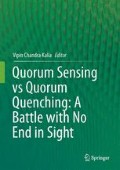Abstract
In several Gram-positive bacteria, competence and sporulation are few of several physiological processes controlled by quorum sensing (QS). Competence is a phenomenon wherein a bacterium acquires extracellular DNA for its maintenance. Only a fraction of cells (10–20 %), in a population, develop competence, at a particular window of growth phase, and in response upregulate expression of genes involved in the uptake and processing of extracellular DNA. Sporulation, second QS-controlled phenotype, occurs under extreme stress and nutritional scarcity. Prolonged nutrient deprivation compels the cell to enter the process of sporulation, the outcome of which is the production of a metabolically dormant endospore that resumes growth once the conditions become favorable again. Spore formation is a complex and tightly regulated phenomenon, where several hundred genes are directly and indirectly involved. Regulation of competence and sporulation is a complex and temporally regulated process. In present chapter, we will discuss QS driven regulation of competence and sporulation in different Gram-positive bacteria.
Access this chapter
Tax calculation will be finalised at checkout
Purchases are for personal use only
References
Bacon Schneider K, Palmer TM, Grossman AD (2002) Characterization of comQ and comX, two genes required for production of ComX pheromone in Bacillus subtilis. J Bacteriol 184(2):410–419
Hamoen LW, Venema G, Kuipers OP (2003) Controlling competence in Bacillus subtilis: shared use of regulators. Microbiology 149(Pt 1):9–17
Johnsborg O, Havarstein LS (2009) Regulation of natural genetic transformation and acquisition of transforming DNA in Streptococcus pneumoniae. FEMS Microbiol Rev 33(3):627–642
Lazazzera BA, Solomon JM, Grossman AD (1997) An exported peptide functions intracellularly to contribute to cell density signaling in B. subtilis. Cell 89(6):917–925
Lopez D, Kolter R (2010) Extracellular signals that define distinct and coexisting cell fates in Bacillus subtilis. FEMS Microbiol Rev 34(2):134–149
Luo P, Li H, Morrison DA (2004) Identification of ComW as a new component in the regulation of genetic transformation in Streptococcus pneumoniae. Mol Microbiol 54(1):172–183
Maamar H, Dubnau D (2005) Bistability in the Bacillus subtilis K-state (competence) system requires a positive feedback loop. Mol Microbiol 56(3):615–624
Mashburn-Warren L, Morrison DA, Federle MJ (2010) A novel double-tryptophan peptide pheromone controls competence in Streptococcus spp. via an Rgg regulator. Mol Microbiol 78(3):589–606
Narula J, Devi SN, Fujita M, Igoshin OA (2012) Ultrasensitivity of the Bacillus subtilis sporulation decision. Proc Natl Acad Sci U S A 109(50):E3513–E3522
Okada M, Sato I, Cho SJ, Iwata H, Nishio T, Dubnau D, Sakagami Y (2005) Structure of the Bacillus subtilis quorum-sensing peptide pheromone ComX. Nat Chem Biol 1(1):23–24
Peterson S, Cline RT, Tettelin H, Sharov V, Morrison DA (2000) Gene expression analysis of the Streptococcus pneumoniae competence regulons by use of DNA microarrays. J Bacteriol 182(21):6192–6202
Waters CM, Bassler BL (2005) Quorum sensing: cell-to-cell communication in bacteria. Annu Rev Cell Dev Biol 21:319–346
Weng L, Piotrowski A, Morrison DA (2013) Exit from competence for genetic transformation in Streptococcus pneumoniae is regulated at multiple levels. PLoS One 8(5):e64197
Author information
Authors and Affiliations
Corresponding author
Editor information
Editors and Affiliations
Rights and permissions
Copyright information
© 2015 Springer India
About this chapter
Cite this chapter
Rai, N., Rai, R., Venkatesh, K.V. (2015). Quorum Sensing in Competence and Sporulation. In: Kalia, V. (eds) Quorum Sensing vs Quorum Quenching: A Battle with No End in Sight. Springer, New Delhi. https://doi.org/10.1007/978-81-322-1982-8_6
Download citation
DOI: https://doi.org/10.1007/978-81-322-1982-8_6
Published:
Publisher Name: Springer, New Delhi
Print ISBN: 978-81-322-1981-1
Online ISBN: 978-81-322-1982-8
eBook Packages: Biomedical and Life SciencesBiomedical and Life Sciences (R0)

